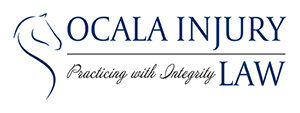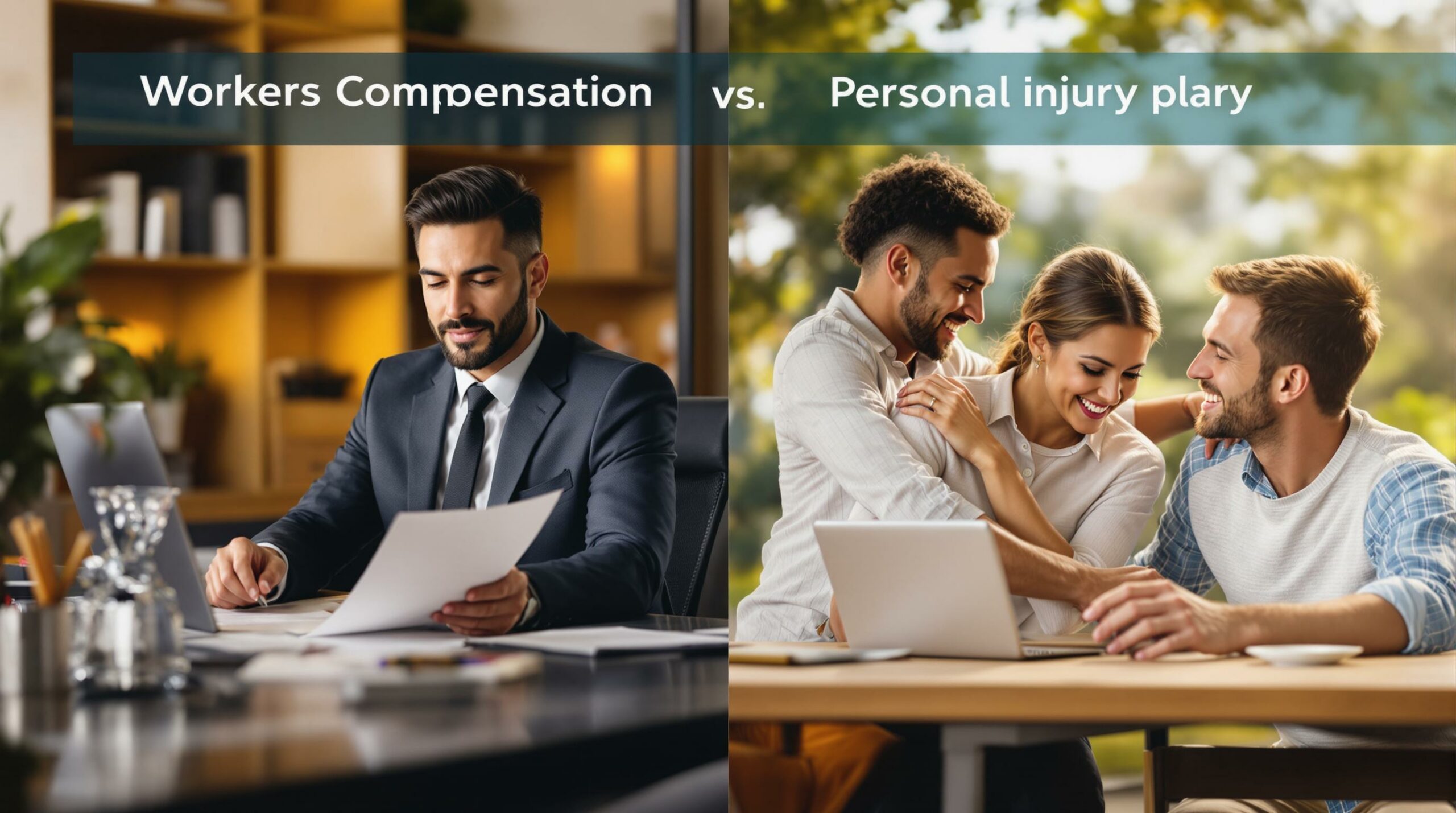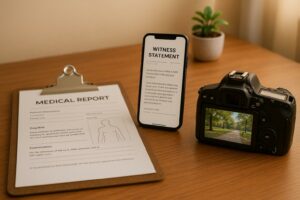When you’re injured, knowing whether to file a workers’ compensation claim or a personal injury claim can make a big difference in the benefits you receive. Here’s a quick breakdown:
- Workers’ Compensation: Covers work-related injuries regardless of fault. It provides medical bills, partial wage replacement, and disability benefits but doesn’t include pain and suffering.
- Personal Injury Claims: Requires proving someone else’s negligence caused your injury. It can cover medical costs, full lost wages, pain and suffering, and other damages.
Quick Comparison:
| Aspect | Workers’ Compensation | Personal Injury Claims |
|---|---|---|
| Fault Requirement | No need to prove fault | Must prove negligence |
| Coverage | Work-related injuries only | Any personal injury |
| Compensation | Limited (no pain & suffering) | Broader, includes pain & suffering |
| Employment Status | Must be an employee | No employment requirement |
| Payment | Weekly benefits | Lump sum after settlement |
If you’re injured at work, you may qualify for both claims in certain cases, like defective equipment. Reporting injuries promptly and consulting a lawyer can help you decide the best path forward.
Who Can File Each Type of Claim
Workers’ Compensation Requirements
To qualify for workers’ compensation, you must be an employee (not an independent contractor) of a company that carries workers’ compensation insurance. Most states require businesses with employees to have this coverage, though private employers in Texas are not mandated to do so.
Your injury or illness must happen during work-related activities that benefit your employer. For example, developing carpal tunnel syndrome from repetitive typing at an office job or injuring your back while lifting boxes in a warehouse are typically covered under workers’ compensation.
Coverage rules vary by state. In North Carolina, businesses with three or more employees are required to carry workers’ compensation insurance. However, certain types of workers may be excluded under state laws, such as:
- Domestic workers
- Agricultural and farm workers
- Seasonal employees
- Leased or loaned workers
On the other hand, personal injury claims operate under a different framework.
Personal Injury Claim Requirements
Personal injury claims require proving that another party’s negligence caused your injury. These claims are not restricted to workplace incidents and can stem from a variety of negligent actions.
Examples of situations that may lead to personal injury claims include:
- Car accidents caused by careless drivers
- Slip and fall incidents due to unsafe property conditions
- Medical malpractice cases
- Injuries caused by defective products
Main Differences in Qualification
Here’s a quick comparison to highlight the key differences between workers’ compensation and personal injury claims:
| Aspect | Workers’ Compensation | Personal Injury Claims |
|---|---|---|
| Employment Status | Must be an employee | No employment requirement |
| Fault Requirement | No need to prove fault | Fault must be proven |
| Incident Location | Work-related only | Can happen anywhere |
| Coverage Scope | Limited to workplace injuries | Covers any type of personal injury |
| Time Requirements | State-specific deadlines | Deadlines vary by statute of limitations |
If you’re injured at work, report it promptly to protect your claim. Also, some workers classified as independent contractors might still qualify as employees under workers’ compensation laws, depending on the circumstances.
Fault Requirements for Each Claim Type
Workers’ Comp: No-Fault System
Workers’ compensation works as a no-fault insurance system. This means employees can receive benefits regardless of who caused the workplace injury. The focus is solely on whether the injury happened during work-related activities, without considering fault.
This no-fault system provides clear advantages for both employees and employers:
| Party | Benefits of No-Fault System |
|---|---|
| Employees | • Quick access to medical benefits • No need to prove employer negligence • Faster claims process |
| Employers | • Protection from injury lawsuits • Lower legal costs |
However, benefits won’t be granted if the injury stems from intoxication, fighting, breaking safety rules on purpose, or illegal activities.
Personal Injury: Proving Fault
Personal injury claims, on the other hand, require proving someone else’s negligence. To succeed, you need to establish four key elements:
- Duty of Care: The other party had a responsibility to act reasonably.
- Breach of Duty: They failed to meet this responsibility.
- Causation: Their actions directly caused your injury.
- Damages: You experienced actual harm or losses.
"The most critical difference between PI and WC claims is that a personal injury claim is based on fault, while a workers’ compensation claim is not." – Kobal Law
How Fault Affects Your Case
The role of fault shapes the process and outcome for each claim type:
| Aspect | Workers’ Compensation | Personal Injury Claims |
|---|---|---|
| Proof Required | Work-related injury only | Evidence of negligence |
| Timeline | Benefits start after claim approval | Payment comes after proving fault |
| Legal Process | Administrative and streamlined | May involve court proceedings |
| Compensation Scope | Limited to specific benefits | Covers a broader range of damages |
In some cases, employers might face additional liability beyond workers’ compensation. This happens if they are found guilty of gross negligence or misconduct – such as maintaining an extremely unsafe workplace or intentionally harming an employee.
Next, we’ll explore how these fault rules influence payments and benefits.
sbb-itb-68ed374
Payment and Benefits Comparison
Knowing the differences between benefits can help you make better choices when navigating claim options.
Workers’ Comp Benefits
Workers’ compensation covers costs related to workplace injuries. In 2020–2021, the average payout was $41,757. These benefits typically include:
- Medical treatment and rehabilitation
- Two-thirds of weekly wages (subject to state caps)
- Rehabilitation services
- Travel reimbursement for medical appointments
- Disability benefits based on the severity of the injury
Some specific cases have notably higher costs. For example, amputation cases average $126,000, while vehicle-related accidents exceed $89,000.
Personal Injury Compensation
Personal injury claims can provide more comprehensive coverage, including:
- Current and future medical expenses
- Full lost wages
- Loss of earning capacity
- Property damage
- Pain and suffering
- Emotional distress
- Loss of enjoyment of life
- Permanent impairment
The table below highlights key differences between these two types of compensation:
| Compensation Type | Workers’ Compensation | Personal Injury Claims |
|---|---|---|
| Medical Coverage | Immediate treatment and rehabilitation | Current and future medical expenses |
| Wage Replacement | Two-thirds of wages (capped) | Full lost wages |
| Pain & Suffering | Not included | Included |
| Disability Benefits | Permanent partial or total disability | Loss of earning capacity |
| Payment Timeline | Weekly benefits after 3–7 days | Lump sum after settlement |
Additional Data on Workplace Injuries
Recent statistics shed light on average payouts for common injuries:
- Fractures or crush injuries: $36,884
- Burns: $38,392
- Sprains or strains: $16,217
- Carpal tunnel syndrome: $15,919
These numbers show the structured nature of workers’ compensation benefits. However, personal injury claims often result in higher payouts due to the inclusion of additional damage categories.
Filing Steps and Time Requirements
It’s important to understand the process and timelines for filing different types of claims so you can act without delay.
How to File Workers’ Comp
To file a workers’ compensation claim in Florida, follow these steps:
-
Report the Injury
Notify your employer about your work-related injury or condition within 30 days of the accident or diagnosis. Reporting promptly helps protect your claim rights. -
Employer’s Response
Your employer has 7 days to report the injury to their insurance carrier. Check your workplace for the carrier’s details. If your employer doesn’t report it, you can reach out to the insurance carrier directly for help. -
Benefits Timeline
If your claim is approved and your disability lasts 8 or more days, you should receive your first benefit check within 14 days of reporting the injury. In Florida, these checks are issued every two weeks and are about 66.67% of your average weekly wage.
How to File Personal Injury Claims
Filing a personal injury claim involves a different approach. Start by documenting the incident and collecting evidence right away. This might include photos, witness statements, and medical records. Consulting an attorney early can help you build a strong case. Keep in mind that the steps and timelines for personal injury claims depend on the specifics of your situation.
Time to Resolve Each Claim Type
The time it takes to resolve workers’ compensation and personal injury claims can vary significantly. Here’s a comparison:
| Aspect | Workers’ Compensation | Personal Injury Claims |
|---|---|---|
| Initial Benefits | Within 21 days of reporting | Varies by case |
| Average Settlement Time | 16 months | Case-dependent |
| Early Resolution Rate | Less than 20% resolved within 6 months | Depends on complexity |
| Typical Timeline | 13–24 months for about 50% of cases | Determined by individual circumstances |
Several factors can influence these timelines. For instance, severe injuries or disputes can extend the process, while thorough documentation may help speed things up. If a workers’ compensation claim is denied, the appeals process could add another 3 to 6 months or more.
"You should report the work-related accident as soon as possible but no later than thirty days from the date the accident occurs, or within thirty days of the date the doctor says you are suffering from a work-related injury. Failure to report your injury or illness within thirty days may result in your claim being denied."
– myfloridacfo.com
Conclusion: Getting Legal Help
Workers’ compensation provides benefits without needing to prove fault, while personal injury claims can secure extra compensation, such as for pain and suffering, when negligence is established.
Given the complexities of these cases, consulting an experienced attorney can help determine your eligibility for one or both types of claims and guide you toward the best path forward.
Early legal advice, a detailed case review, and strong representation are key to ensuring you receive the full benefits you’re entitled to.
Attorney Alida "Ali" Catherine Darias focuses on helping injured workers by offering tailored consultations to identify the best legal strategy for their situation.
While workers’ compensation often prevents lawsuits against your employer, you might still be able to pursue additional compensation through third-party claims. A detailed case evaluation can help identify all possible options for securing the compensation you need.
If you’re ready to explore your legal options, contact Ocala Injury Law for a free consultation. They can help you decide whether a workers’ compensation claim, personal injury lawsuit, or both are the right choices for your case.




